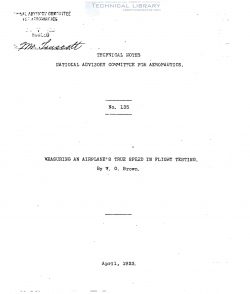naca-tn-135
- Version
- 126 Downloads
- 663.41 KB File Size
- 1 File Count
- November 3, 2016 Create Date
- November 3, 2016 Last Updated
National Advisory Committee for Aeronautics, Technical Notes - Measuring an Airplane's True Speed in Flight Testing

For the ordinary range of flying where the pilot never
knows the exact velocity and direction of the wind, the airspeed
meter serves more as a stability indicator than it does as a true
instrument of navigation. The pilot depends upon it as he de-
pends upon the sound of the interplane wires or the stiffness
of the controls to tell in What part of the flying range the
airplane is operating. Except possibly in navigating over the
sea_where the winds are steady and can be allowed for, an error
of a few miles per hour is of no great consequence.
In competitive performance measurement or full scale scien—
tific research a more exact knowledge of speed is necessary.
Since many of the airplanes in use during the war were equipped
with airspeed meters, of the Pitot or Venturi type it became
common practice to carefully calibrate these instruments and to
use their corrected readings for scientific purposes. Toussaint*
in France, and Tizard** in England developed similar methods for
determining true speed in performance testing which with modifi—
cations are still in use today. Briefly, their methods consist
in dividing the airspeed meter error into three parts! (1) The
error of the gage in transmitting the pressure difference pro—
duced by the tube into speed under standard and ideal condi—
tions; (8) the error due to variations of the density from the
standard for which the instrument is calibrated; and (3) the
error due to the particular location of the airspeed meter
head on the airplane.
The first error is determined by calibration in the labor~
atory. The second is computed from the observations of pres-
sure and temperature during the test. The third is the resid—
ual error determined by timing the airplane over a known dise
tance, and is by far the most difficult to determine precisely.
Unfortunately, since the airplane flies through the air
its speed must be observed relative to the air and not relative
to the ground, or if observed relative to the ground a correc—
tion must be made for the amount by which the airplane‘s Speed
is reduced or augmented by the wind.
| File | Action |
|---|---|
| naca-tn-135 Measuring an Airplane's True Speed in Flight Testing.pdf | Download |

Comment On This Post